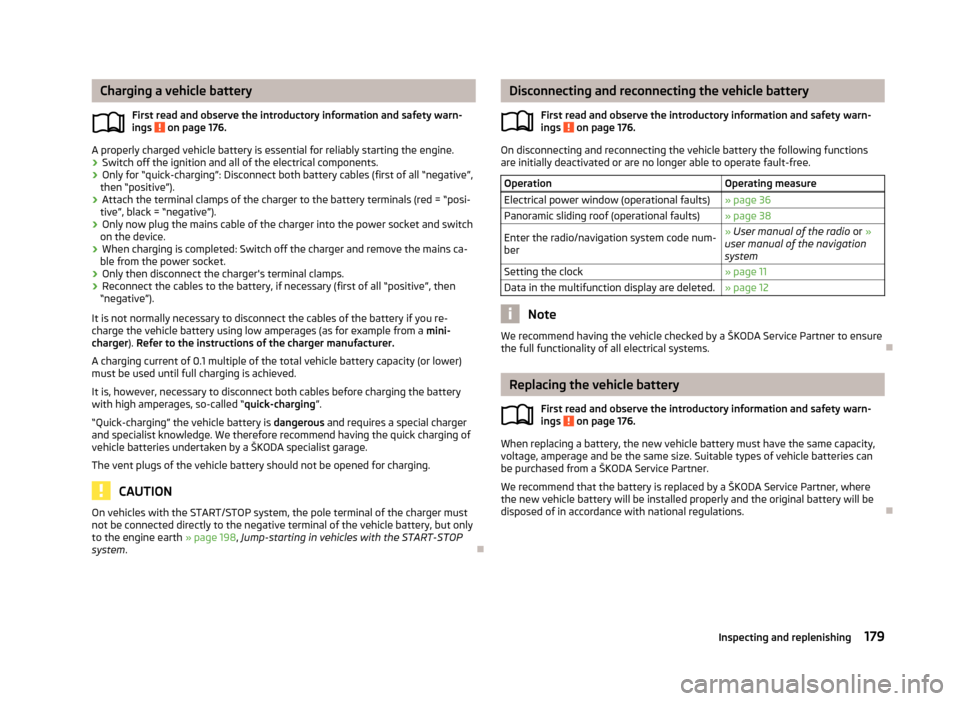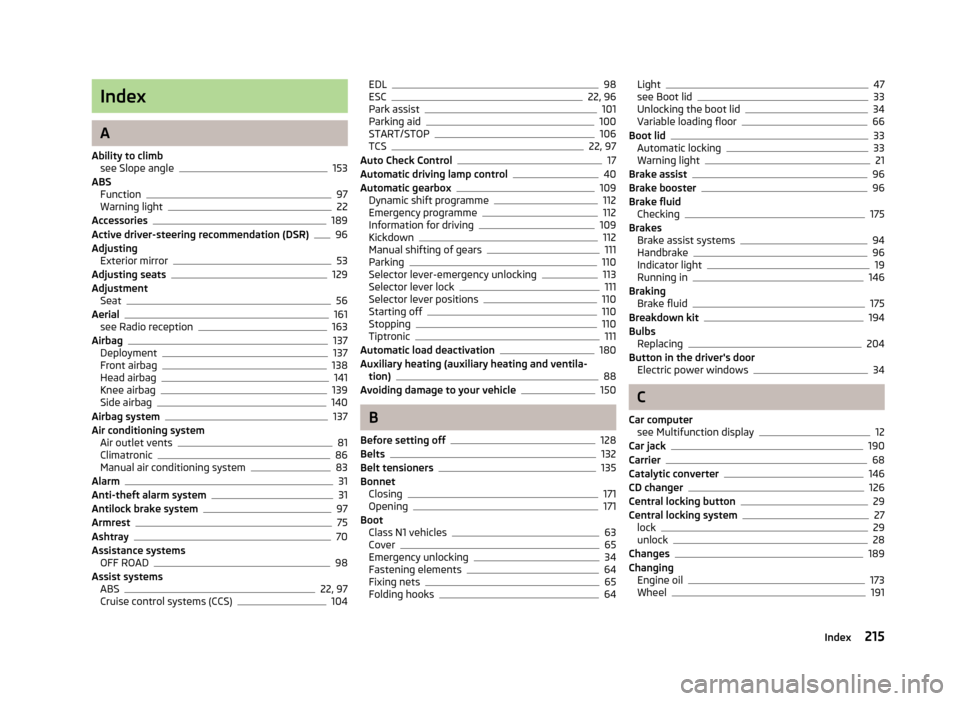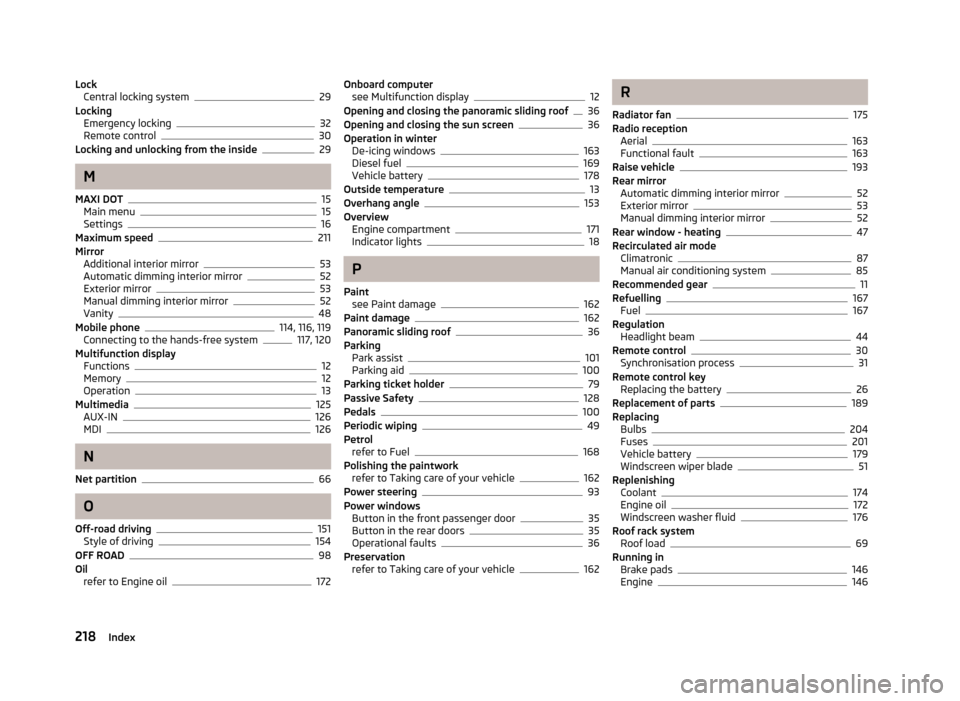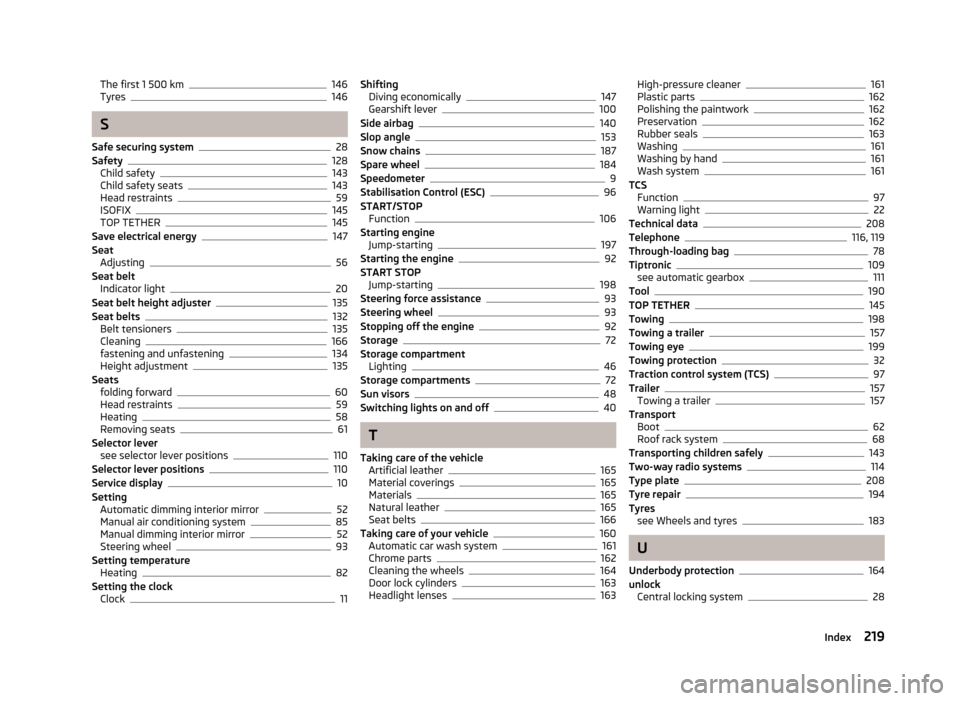manual radio set SKODA YETI 2012 1.G / 5L Owner's Manual
[x] Cancel search | Manufacturer: SKODA, Model Year: 2012, Model line: YETI, Model: SKODA YETI 2012 1.G / 5LPages: 225, PDF Size: 5.47 MB
Page 88 of 225

Climatronic (automatic air conditioning system)
Introductory information
The Climatronic maintains fully automatically a convenience temperature. This is
achieved by automatically varying the temperature of the air flow, the blower
stages and air distribution. The system also takes sunlight into account, which
eliminates the need to alter the settings manually. The automatic
mode » page 87 ensures maximum well-being of the occupants at all times of
the year.
Description of Climatronic system
The cooling system only operates if the following conditions are met:
› engine running;
› outside temperature above approx. +2 °C;
› AC 13
» Fig. 91 on page 86
switched on.
The AC compressor is switched off at a high coolant temperature in order to pro-
vide cooling at a high load of the engine.
Recommended setting for all periods of the year.
› Set the desired temperature, we recommend 22 °C.
› Press the button
AUTO 8
» Fig. 91
on page 86.
› Move the air outlet vents
3 and 4 » Fig. 87 on page 81 so that the air flow is
directed slightly upwards. Note
■ We recommend that you have the Climatronic system cleaned by a
ŠKODA spe-
cialist garage once every year. ■ On vehicles equipped with a factory-fitted radio or radio navigation system, the
Climatronic information is also shown on their displays. This function can be
switched off, see operating instructions for the radio or navigation system. Ð Overview of the control elements
Fig. 91
Climatronic: Control elements
The buttons Defrost windscreen intensively Air flow to the windows
Air flow to head
Air flow in the footwell
Recirculated air mode
with air quality sensor
Rear window heater The buttons/control dial
Setting of the temperature for the left side, operation of the seat heating of
the left front seat
Automatic mode AUTO Switching off Climatronic
OFF Setting the blower speed
Depending upon vehicle equipment: Button for directly switching on/off the
auxiliary heating » Fig. 92
on page
89 or switching on/off the windscreen
heater » Fig. 34 on page 47
Switching on/off of the temperature setting in dual mode DUAL Switching the cooling system on and off
AC Setting of the temperature for the right side, operation of the seat heating of
the right front seat £ 1
2
3
4
5
6
7
8
9
10
11
12
13
14
86
Using the system
Page 90 of 225

Switch on automatic air distribution control
›
Repeatedly press the button
until the indicator light on the right side of
the button is illuminated.
Switch off automatic air distribution control temporarily › If the air quality sensor does not automatically switch on the air distribution
control in the event of an unpleasant odour, you can switch it on yourself by
pressing the button . The indicator light lights up in the button on the left
side.
Switching recirculated air mode off › Press the button
AUTO or repeatedly press the button
until the indicator
lights in the button go out. WARNING
Do not leave recirculated air mode on over a longer period of time, as “stale”
air can cause fatigue of the driver and passengers, reduce attention levels and
also cause the windows to mist up. The risk of having an accident increases.
Switch off recirculated air mode as soon as the windows start to mist up. Note
■ If the windscreen mists up, press the button 1
» Fig. 91 on page 86
. Press
the button AUTO when the windscreen is demisted.
■ The automatic air distribution control operates only if the outside temperature
is higher than approx. 2 °C. ÐControlling blower
The Climatronic system controls the blower stages automatically in line with the
interior temperature. However, the blower stages can be manually adapted to
suit your particular needs.
› Repeatedly press the button
» Fig. 91 on page 86
on the left side (reduce
blower speed) or on the right side (increase blower speed).
If the blower is switched off, the Climatronic system is switched off.
The set blower speed is displayed above the button when the respective num-
ber of indicator lights come on. WARNING
■ “
Stale air” may result in fatigue in the driver and occupants, reduce attention
levels and also cause the windows to mist up. The risk of having an accident
increases.
■ Do not switch off the Climatronic system for longer than necessary.
■ Switch on the Climatronic system as soon as the windows mist up. Ð Defrosting windscreen
Switching on › Press the button
1
» Fig. 91
on page
86.
› Press the button
11
» Fig. 91
on page 86.
Switching off
› Press the button
1
» Fig. 91
on page
86 again or press the button 8
AUTO
.
› Press the button
11
» Fig. 91
on page 86 again.
The temperature control is controlled automatically. More air flows out of the air
outlet vents 1
and 2 » Fig. 87 on page 81. Ð Auxiliary heating (auxiliary heating and ventilation)
ä
Introduction
This chapter contains information on the following subjects:
Direct switching on/off 89
System settings 90
Radio remote control 90
Changing the battery of the radio remote control 91
Auxiliary heating (parking heating)
The auxiliary heating (auxiliary heating) functions in connection with the air-con-
ditioning system or Climatronic.
It can be used when stationary, when the engine is switched off to preheat the
vehicle and while driving (e.g. during the heating phase of the engine). £
88 Using the system
Page 181 of 225

Charging a vehicle battery
First read and observe the introductory information and safety warn-
ings on page 176.
A properly charged vehicle battery is essential for reliably starting the engine.
› Switch off the ignition and all of the electrical components.
› Only for “quick-charging”: Disconnect both battery cables (first of all “negative”,
then “positive”).
› Attach the terminal clamps of the charger to the battery terminals (red =
“posi-
tive
”, black = “negative”).
› Only now plug the mains cable of the charger into the power socket and switch
on the device.
› When charging is completed: Switch off the charger and remove the mains ca-
ble from the power socket.
› Only then disconnect the charger's terminal clamps.
› Reconnect the cables to the battery, if necessary (first of all
“positive”, then
“negative
”).
It is not normally necessary to disconnect the cables of the battery if you re-
charge the vehicle battery using low amperages (as for example from a mini-
charger). Refer to the instructions of the charger manufacturer.
A charging current of 0.1 multiple of the total vehicle battery capacity (or lower)
must be used until full charging is achieved.
It is, however, necessary to disconnect both cables before charging the battery
with high amperages, so-called “ quick-charging”.
“Quick-charging” the vehicle battery is dangerous and requires a special charger
and specialist knowledge. We therefore recommend having the quick charging of
vehicle batteries undertaken by a ŠKODA specialist garage.
The vent plugs of the vehicle battery should not be opened for charging. CAUTION
On vehicles with the START/STOP system, the pole terminal of the charger must
not be connected directly to the negative terminal of the vehicle battery, but only
to the engine earth » page 198, Jump-starting in vehicles with the
START-STOP
system . Ð
ä Disconnecting and reconnecting the vehicle battery
First read and observe the introductory information and safety warn-
ings on page 176.
On disconnecting and reconnecting the vehicle battery the following functions
are initially deactivated or are no longer able to operate fault-free.
Operation Operating measure
Electrical power window (operational faults) » page 36
Panoramic sliding roof (operational faults) » page 38
Enter the radio/navigation system code num-
ber » User manual of the radio
or »
user manual of the navigation
system
Setting the clock » page 11
Data in the multifunction display are deleted. » page 12 Note
We recommend having the vehicle checked by a ŠKODA Service Partner to ensure
the full functionality of all electrical systems. Ð Replacing the vehicle battery
First read and observe the introductory information and safety warn-
ings on page 176.
When replacing a battery, the new vehicle battery must have the same capacity,
voltage, amperage and be the same size. Suitable types of vehicle batteries can
be purchased from a
ŠKODA Service Partner.
We recommend that the battery is replaced by a ŠKODA Service Partner, where
the new vehicle battery will be installed properly and the original battery will be
disposed of in accordance with national regulations. Ð
ä
ä
179
Inspecting and replenishing
Page 217 of 225

Index
A
Ability to climb see Slope angle 153
ABS Function 97
Warning light 22
Accessories 189
Active driver-steering recommendation (DSR) 96
Adjusting Exterior mirror 53
Adjusting seats 129
Adjustment Seat 56
Aerial 161
see Radio reception 163
Airbag 137
Deployment 137
Front airbag 138
Head airbag 141
Knee airbag 139
Side airbag 140
Airbag system 137
Air conditioning system Air outlet vents 81
Climatronic 86
Manual air conditioning system 83
Alarm 31
Anti-theft alarm system 31
Antilock brake system 97
Armrest 75
Ashtray 70
Assistance systems OFF ROAD 98
Assist systems ABS 22, 97
Cruise control systems (CCS) 104EDL 98
ESC 22, 96
Park assist 101
Parking aid 100
START/STOP 106
TCS 22, 97
Auto Check Control 17
Automatic driving lamp control 40
Automatic gearbox 109
Dynamic shift programme 112
Emergency programme 112
Information for driving 109
Kickdown 112
Manual shifting of gears 111
Parking 110
Selector lever-emergency unlocking 113
Selector lever lock 111
Selector lever positions 110
Starting off 110
Stopping 110
Tiptronic 111
Automatic load deactivation 180
Auxiliary heating (auxiliary heating and ventila- tion) 88
Avoiding damage to your vehicle 150
B
Before setting off 128
Belts 132
Belt tensioners 135
Bonnet Closing 171
Opening 171
Boot Class
N1 vehicles 63
Cover 65
Emergency unlocking 34
Fastening elements 64
Fixing nets 65
Folding hooks 64Light 47
see Boot lid 33
Unlocking the boot lid 34
Variable loading floor 66
Boot lid 33
Automatic locking 33
Warning light 21
Brake assist 96
Brake booster 96
Brake fluid Checking 175
Brakes Brake assist systems 94
Handbrake 96
Indicator light 19
Running in 146
Braking Brake fluid 175
Breakdown kit 194
Bulbs Replacing 204
Button in the driver's door Electric power windows 34
C
Car computer see Multifunction display 12
Car jack 190
Carrier 68
Catalytic converter 146
CD changer 126
Central locking button 29
Central locking system 27
lock 29
unlock 28
Changes 189
Changing Engine oil 173
Wheel 191
215
Index
Page 220 of 225

Lock
Central locking system 29
Locking Emergency locking 32
Remote control 30
Locking and unlocking from the inside 29
M
MAXI DOT 15
Main menu 15
Settings 16
Maximum speed 211
Mirror Additional interior mirror 53
Automatic dimming interior mirror 52
Exterior mirror 53
Manual dimming interior mirror 52
Vanity 48
Mobile phone 114, 116, 119
Connecting to the hands-free system 117, 120
Multifunction display Functions 12
Memory 12
Operation 13
Multimedia 125
AUX-IN 126
MDI 126
N
Net partition 66
O
Off-road driving 151
Style of driving 154
OFF ROAD 98
Oil refer to Engine oil 172Onboard computer
see Multifunction display 12
Opening and closing the panoramic sliding roof 36
Opening and closing the sun screen 36
Operation in winter De-icing windows 163
Diesel fuel 169
Vehicle battery 178
Outside temperature 13
Overhang angle 153
Overview Engine compartment 171
Indicator lights 18
P
Paint see Paint damage 162
Paint damage 162
Panoramic sliding roof 36
Parking Park assist 101
Parking aid 100
Parking ticket holder 79
Passive Safety 128
Pedals 100
Periodic wiping 49
Petrol refer to Fuel 168
Polishing the paintwork refer to Taking care of your vehicle 162
Power steering 93
Power windows Button in the front passenger door 35
Button in the rear doors 35
Operational faults 36
Preservation refer to Taking care of your vehicle 162 R
Radiator fan 175
Radio reception Aerial 163
Functional fault 163
Raise vehicle 193
Rear mirror Automatic dimming interior mirror 52
Exterior mirror 53
Manual dimming interior mirror 52
Rear window - heating 47
Recirculated air mode Climatronic 87
Manual air conditioning system 85
Recommended gear 11
Refuelling 167
Fuel 167
Regulation Headlight beam 44
Remote control 30
Synchronisation process 31
Remote control key Replacing the battery 26
Replacement of parts 189
Replacing Bulbs 204
Fuses 201
Vehicle battery 179
Windscreen wiper blade 51
Replenishing Coolant 174
Engine oil 172
Windscreen washer fluid 176
Roof rack system Roof load 69
Running in Brake pads 146
Engine 146
218 Index
Page 221 of 225

The first 1 500 km 146
Tyres 146
S
Safe securing system 28
Safety 128
Child safety 143
Child safety seats 143
Head restraints 59
ISOFIX 145
TOP TETHER 145
Save electrical energy 147
Seat Adjusting 56
Seat belt Indicator light 20
Seat belt height adjuster 135
Seat belts 132
Belt tensioners 135
Cleaning 166
fastening and unfastening 134
Height adjustment 135
Seats folding forward 60
Head restraints 59
Heating 58
Removing seats 61
Selector lever see selector lever positions 110
Selector lever positions 110
Service display 10
Setting Automatic dimming interior mirror 52
Manual air conditioning system 85
Manual dimming interior mirror 52
Steering wheel 93
Setting temperature Heating 82
Setting the clock Clock 11Shifting
Diving economically 147
Gearshift lever 100
Side airbag 140
Slop angle 153
Snow chains 187
Spare wheel 184
Speedometer 9
Stabilisation Control (ESC) 96
START/STOP Function 106
Starting engine Jump-starting 197
Starting the engine 92
START STOP Jump-starting 198
Steering force assistance 93
Steering wheel 93
Stopping off the engine 92
Storage 72
Storage compartment Lighting 46
Storage compartments 72
Sun visors 48
Switching lights on and off 40
T
Taking care of the vehicle Artificial leather 165
Material coverings 165
Materials 165
Natural leather 165
Seat belts 166
Taking care of your vehicle 160
Automatic car wash system 161
Chrome parts 162
Cleaning the wheels 164
Door lock cylinders 163
Headlight lenses 163High-pressure cleaner 161
Plastic parts 162
Polishing the paintwork 162
Preservation 162
Rubber seals 163
Washing 161
Washing by hand 161
Wash system 161
TCS Function 97
Warning light 22
Technical data 208
Telephone 116, 119
Through-loading bag 78
Tiptronic 109
see automatic gearbox 111
Tool 190
TOP TETHER 145
Towing 198
Towing a trailer 157
Towing eye 199
Towing protection 32
Traction control system (TCS) 97
Trailer 157
Towing a trailer 157
Transport Boot 62
Roof rack system 68
Transporting children safely 143
Two-way radio systems 114
Type plate 208
Tyre repair 194
Tyres see Wheels and tyres 183
U
Underbody protection 164
unlock Central locking system 28
219
Index